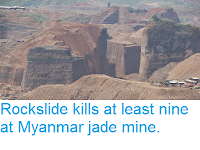Nine people have died and at least one has been injured following a landslide at a jade mine in the village of Nanthmaw near Hpakant in Kachin State on Thursday 9 February 2017. Five bodies and two survivors were pulled from the debris on Thursday, though one of the survivors later died in hospital, and a further three bodies were recovered on Friday. The incident occurred on a spoil heap produced by a large mining concern that was
itself being worked by smaller artisanal miners looking for pieces of
jade missed by the larger operation.
The approximate location of the 9 February 2017 Hpakant landslip. Google Maps.
Myanmar is the world's largest producer of jade, though much of this is
produced (along with other precious and semi-precious minerals such as
amber) at unregulated (and often illegal) artisanal mines in the north
of the country, from where it is smuggled into neighbouring China.
Accidents at such mines are extremely common, due to the more-or-less
total absence of any safety precautions at the site. At many sites this
is made worse by the unregulated use of explosives to break up rocks,
often leading to the weakening of rock faces, which can then collapse
without warning. The majority of people in this industry are migrant
workers from the
surrounding countryside, not registered with any local authority, which
can make it difficult for rescuers to identify victims following such
events, or even gain accurate assessments of the number of people likely
to have been involved in such accidents.
See also...
Follow Sciency Thoughts on Facebook.







